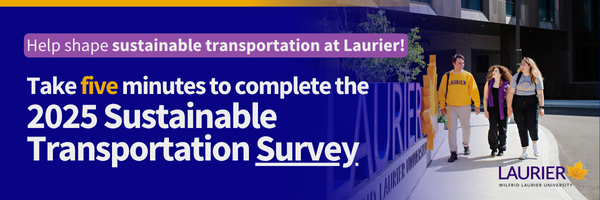Your Commute Counts: Fill out the 2025 Sustainable Transportation Survey – Wilfrid Laurier University

Report on the 2025 Sustainable Transportation Survey Initiative
Introduction
The Sustainability Office has initiated the 2025 Sustainable Transportation Survey to conduct a comprehensive analysis of the commuting patterns of its students, staff, and faculty. This initiative is a critical component of the university’s strategy to advance key United Nations Sustainable Development Goals (SDGs) by gathering data to shape a more sustainable, low-carbon campus community.
Strategic Objectives and Alignment with Sustainable Development Goals (SDGs)
The survey is designed to achieve four primary objectives, each directly contributing to specific SDGs and the university’s commitment to a sustainable future.
-
Assess Campus-wide Modal Splits
This objective aims to establish a clear baseline of current transportation methods used by the campus community. The data is fundamental to achieving SDG 11 (Sustainable Cities and Communities), particularly Target 11.2, which focuses on providing access to safe, affordable, and sustainable transport systems for all.
-
Support Scope 3 Emissions Tracking
The survey data will be instrumental in calculating the carbon footprint associated with commuting. This directly supports SDG 13 (Climate Action) by enabling the institution to accurately monitor and manage its indirect greenhouse gas emissions, a crucial step in developing effective climate mitigation strategies.
-
Identify Barriers to Sustainable Transportation
By uncovering demographic, infrastructural, and geographic challenges, the survey will identify impediments to the adoption of sustainable transport. This aligns with SDG 9 (Industry, Innovation, and Infrastructure) and SDG 11, as the findings will inform targeted investments in resilient and inclusive infrastructure that promotes green commuting options.
-
Inform Future Strategies for Modal Shift
Insights gathered will inform the development of future transportation policies and infrastructure projects designed to encourage a campus-wide shift toward sustainable commuting. This objective contributes to a range of goals, including SDG 3 (Good Health and Well-being) by promoting active transport, SDG 7 (Affordable and Clean Energy) by reducing fossil fuel dependency, and reinforcing commitments to SDG 11 and SDG 13.
Methodology and Participation
The survey is administered as an anonymous online questionnaire, open to all students, staff, and faculty. The estimated completion time is between five and ten minutes. The data collected on commuting habits, barriers, and opportunities will inform evidence-based decision-making to advance the institution’s sustainability targets.
Participant Incentives
To encourage a high response rate, the following prize draws are available to participants:
-
For Waterloo and Kitchener Faculty and Staff:
- Eight $45 EasyGo cards
- Ten $50 MEC cards
- Ten transportation-themed prize packs (valued at $50)
-
For Brantford and Milton Faculty and Staff:
- Four $75 commuter prize packs
-
For Students (All Campuses):
- Six $50 MEC gift cards
- Six $50 well.ca gift cards
Conclusion
Participation in this survey is vital for understanding the environmental impact of daily commuting and for advancing the university’s commitment to the Sustainable Development Goals. The resulting data will directly inform strategies to create a healthier, more accessible, and climate-resilient campus community. For more information or for an accessible version of the survey, please contact Kat in the Sustainability Office at kmilicic@wlu.ca.
1. Which SDGs are addressed or connected to the issues highlighted in the article?
The article on the 2025 Sustainable Transportation Survey connects to several Sustainable Development Goals (SDGs) by focusing on environmental impact, community infrastructure, and climate action within the university community.
-
SDG 11: Sustainable Cities and Communities
This goal is central to the article’s theme. The survey aims to understand and improve transportation systems within the campus community, which functions as a micro-city. It focuses on making transportation more sustainable by assessing how people travel, identifying barriers, and informing future infrastructure, directly contributing to creating a more sustainable community.
-
SDG 13: Climate Action
The article explicitly links the transportation survey to climate action by stating its purpose is to “Support Scope 3 Emissions Tracking” and “understand the emissions footprint from commuting.” This initiative is a direct measure to gather data needed to reduce greenhouse gas emissions and support the university’s “commitment to a low-carbon future.”
-
SDG 9: Industry, Innovation and Infrastructure
The survey’s goal to “Identify Barriers to Sustainable Transportation,” including “infrastructure… challenges,” and to “Inform Future Strategies for Modal Shift” and “transportation infrastructure” directly relates to this SDG. It is an effort to gather data to innovate and develop more sustainable and resilient infrastructure for the campus community.
2. What specific targets under those SDGs can be identified based on the article’s content?
The article’s objectives align with several specific targets under the identified SDGs.
-
SDG 11: Sustainable Cities and Communities
- Target 11.2: By 2030, provide access to safe, affordable, accessible and sustainable transport systems for all. The survey is a foundational step toward this target. By seeking to “establish a clear picture of how everyone travels to and from campus” and identifying “barriers to sustainable transportation,” the university is working to understand and improve access to sustainable transport options like walking, biking, and public transit for its entire community.
- Target 11.6: By 2030, reduce the adverse per capita environmental impact of cities. The article highlights that the survey will help “understand the environmental impact of our daily commuting habits” and track the “emissions footprint from commuting.” This data is essential for developing strategies to reduce the community’s overall environmental impact.
-
SDG 13: Climate Action
- Target 13.2: Integrate climate change measures into national policies, strategies and planning. On an institutional level, this survey is a tool to integrate climate change measures into the university’s planning. The article states that the “insights gathered will inform transportation infrastructure and reaffirm Laurier’s commitment to a low-carbon future,” demonstrating a strategic approach to climate action.
-
SDG 9: Industry, Innovation and Infrastructure
- Target 9.1: Develop quality, reliable, sustainable and resilient infrastructure. The survey’s objective to “identify… infrastructure… challenges” is directly aimed at improving transportation infrastructure. The data collected will “inform future strategies” for infrastructure development that supports sustainable transportation modes, making it more reliable and accessible for the community.
3. Are there any indicators mentioned or implied in the article that can be used to measure progress towards the identified targets?
Yes, the article mentions and implies several key performance indicators that can be used to measure progress.
-
Indicators for SDG 11 (Targets 11.2 & 11.6)
- Campus-wide Modal Splits: The article explicitly states the survey will “Assess Campus-wide Modal Splits.” This serves as a direct indicator for Target 11.2, measuring the proportion of the community using different forms of transportation (walking, biking, transit, single-occupancy vehicles). Progress can be measured by tracking a shift towards more sustainable modes over time.
- Commuting Emissions Footprint: The goal to “Support Scope 3 Emissions Tracking” and understand the “emissions footprint from commuting” provides a quantifiable indicator for Target 11.6. Measuring the total greenhouse gas emissions from commuting allows the university to set reduction targets and track progress toward a lower environmental impact.
-
Indicator for SDG 9 (Target 9.1)
- Identified Barriers to Sustainable Transportation: The survey aims to “uncover the demographic, infrastructure, and geographic challenges.” The number and type of identified barriers (e.g., lack of secure bike parking, unsafe pedestrian crossings, poor transit service) serve as an indicator. Progress can be measured by the reduction of these identified barriers through targeted infrastructure and policy changes.
4. Create a table with three columns titled ‘SDGs, Targets and Indicators” to present the findings from analyzing the article. In this table, list the Sustainable Development Goals (SDGs), their corresponding targets, and the specific indicators identified in the article.
| SDGs | Targets | Indicators |
|---|---|---|
| SDG 11: Sustainable Cities and Communities | Target 11.2: Provide access to safe, affordable, accessible and sustainable transport systems for all. | Proportion of the campus community using sustainable transportation modes (measured by “Campus-wide Modal Splits”). |
| SDG 11: Sustainable Cities and Communities | Target 11.6: Reduce the adverse per capita environmental impact of cities. | Total greenhouse gas emissions from commuting by the campus community (measured via “Scope 3 Emissions Tracking”). |
| SDG 13: Climate Action | Target 13.2: Integrate climate change measures into policies, strategies and planning. | Implementation of strategies informed by survey data to create a “low-carbon future” (measured by the “emissions footprint from commuting”). |
| SDG 9: Industry, Innovation and Infrastructure | Target 9.1: Develop quality, reliable, sustainable and resilient infrastructure. | Number and type of “demographic, infrastructure, and geographic challenges” identified by the survey, and subsequent reduction of these barriers. |
Source: students.wlu.ca
What is Your Reaction?
 Like
0
Like
0
 Dislike
0
Dislike
0
 Love
0
Love
0
 Funny
0
Funny
0
 Angry
0
Angry
0
 Sad
0
Sad
0
 Wow
0
Wow
0
















































:focal(1500,1000)/https://media.globalcitizen.org/a6/9a/a69a4720-d8a1-4715-b596-18738d03c05c/rotary_polio_hero_image.jpg?#)







/countries/sri-lanka/photo-credit---dmc-sri-lanka.tmb-1200v.jpg?sfvrsn=dc298bcc_1#)
















